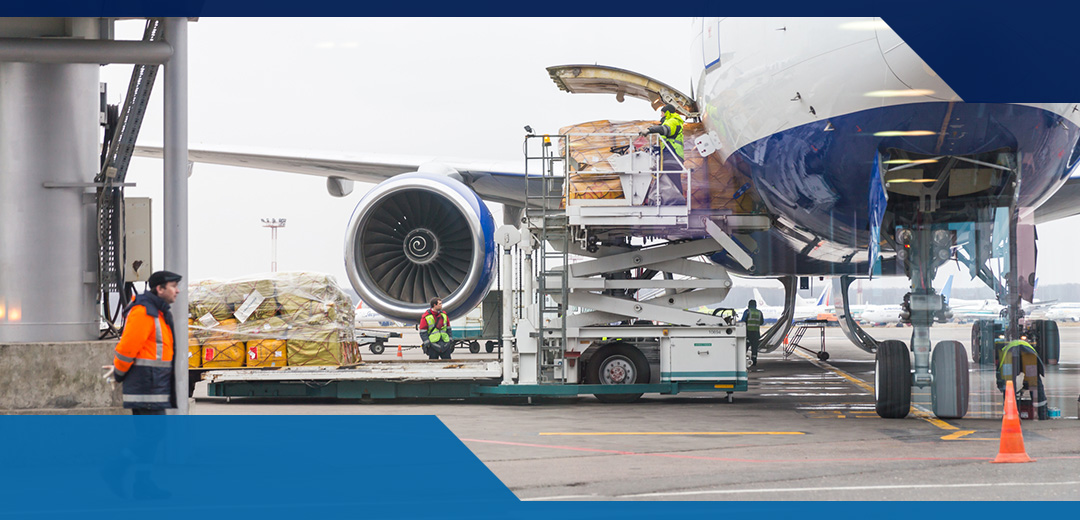
With tens of thousands of airports worldwide, it makes sense that the industry follows a systemized approach to keep everything running smoothly. The International Air Transport Association (IATA) is tasked with developing regulations, setting up procedures and creating digital tools to make air transport safer and more efficient.
IATA codes are three-letter airport codes that are especially critical for air freight logistics professionals. They help you communicate more easily with stakeholders, streamline documentation and complete tasks when working across different airlines and airports. Discover all you need to know about IATA codes and their role in logistics here.
What Is an IATA Code?
IATA codes are a diverse set of numbers that register and categorize airports and airlines globally. These codes consist of three-letter combinations — a shorthand for specific locations and airlines. For example, the IATA flight code for American Airlines is “AA,” while the airport code for Los Angeles International Airport is “LAX.”
This uniformity helps logistics professionals quickly identify flight paths, schedule shipments and complete documentation without confusion. IATA codes help the aviation and logistics industry communicate and manage ticketing, baggage handling and other air freight operations. When planning air freight routes, the codes help you direct your shipments to the right terminals. They also streamline processes like documentation, making it easy to identify locations across carriers and systems.
The first coding system for airports was introduced in the 1930s, which used two-letter codes chosen by the airport. However, with the fast rise of modern aviation and the growing number of airports worldwide, the two-letter coding system was no longer enough. The industry upgraded to three-letter codes in the late 1940s, and the IATA took control of the codes in the 1960s — introducing the standardized system used today.
Do All Airports Have IATA Codes?
Not every airport has an IATA code. The IATA system was made for airports that deal with significant passenger and cargo traffic, so some lesser-known or less-frequented airports don’t always use IATA codes. Most commonly, major international and regional airports use IATA codes, though smaller, private airstrips can, too.
Additionally, due to the three-letter character limit, not all IATA codes are unique, so airports can have similar or even the same codes. For instance, airports in the same region might have codes that start with the same first letter. As a logistics professional, you need to know which airports use these three-digit codes and verify those that use the same code to avoid mishaps when scheduling shipments.
How Are IATA Codes Assigned?
IATA codes are assigned in two ways — how the airport wants to be identified, and the availability of a three-character combination. Typically, the airport will propose a list of codes to the IATA, which then evaluates their availability and grants approval. Methods for assigning codes include:
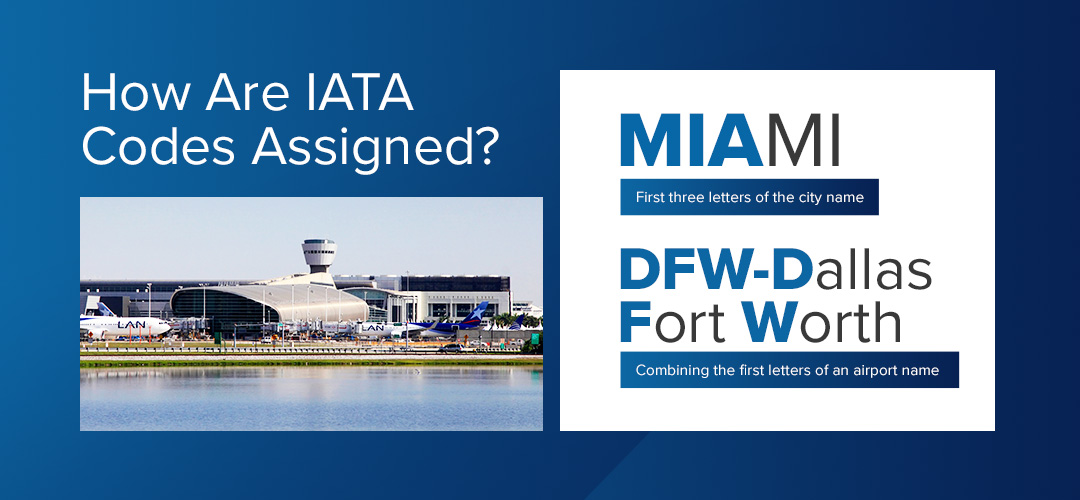
- First three letters of the city name: The most common approach to assigning codes is using the first three letters of the city name, like “MIA” for Miami and “MAD” for Madrid.
- Combining the first letters of an airport name: Another method is combining the first letters of the complete airport name, like “JFK” for New York — John F. Kennedy, “CDG” for Paris — Charles de Gaulle, or “DFW for Dallas” — Forth Worth.
If a city is served by multiple airports, IATA assigns codes to the metropolitan areas, as well. For instance, the New York City area is designated as “NYC,” which differs from nearby airports like John F. Kennedy International Airport (JFK) and LaGuardia Airport (LGA). Sometimes, IATA location codes are also assigned to non-airport locations connected to air travel, such as trains and bus stations.
How Many IATA Airport Codes Are There?
Approximately 11,300 IATA airport codes are currently assigned. There are over 17,000 possible code combinations, and the IATA typically assigns around 40 to 50 new codes each year. This number fluctuates due to the opening of new airports or the closure of existing ones.
The distribution of IATA codes isn’t uniform — some countries have more airports and, as a result, more IATA codes. For instance, the United States has the largest number of IATA codes due to its extensive network of airports.
Staying updated on changes in IATA codes, such as new assignments or deletions, will help you document your shipments, avoid errors and prevent delays in customs processing.
The Importance of IATA Codes
The significance of IATA codes goes beyond identification. Accurately referencing and using IATA codes will improve your efficiency and overall service quality. It can also help you provide more accurate information to clients and respond to shipping challenges. Overall, IATA codes are essential for smooth, effective air freight logistics.
Reference Flight Schedules
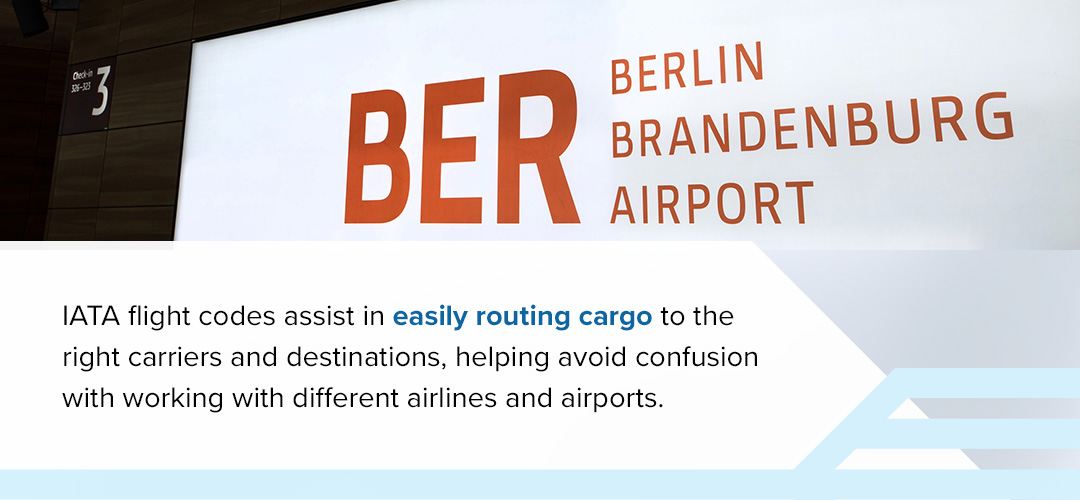
Understand Layover Requirements
Many air freight shipments involve layovers at different airports. Understanding the relevant IATA codes will help you find connecting flights and determine how long layovers will be, which is essential in managing your transit times. As a result, you can improve the chances of your shipments arriving at their final destinations without delays.
Coordinate With Stakeholders
As you know, collaboration is an essential aspect of air freight — you’re constantly working with various parties, from shippers and freight forwarders to customs brokers and different airlines. IATA codes are the common language you share that makes communication much easier. They help reduce the risks of mistakes and make sure everyone is on the same page regarding shipment details.
Comply With International Shipping Regulations
IATA codes are integral to the documentation required for international shipping. Many customs processes require accurate coding, and using incorrect IATA codes can lead to delays or fines. Ensure you use the right codes to prevent customs issues and maintain compliance with regulations.
Enhance Efficiency
IATA codes make your job more straightforward, streamlining operations in an industry where timely deliveries are critical. For example, they simplify the tracking process, helping you monitor your shipments in real time and address issues. They also help with warehouse and inventory management, as you know the exact airport codes to store and handle shipments based on their expected arrival times.
This level of organization can improve your logistics workflow and lead to faster, more accurate deliveries.
How to Find an IATA Code
Finding IATA codes is simple thanks to all the resources available to logistics professionals. The official IATA website includes the full database of codes, as do most commercial airlines and flight booking platforms. Here are some methods you can use to locate an IATA code:
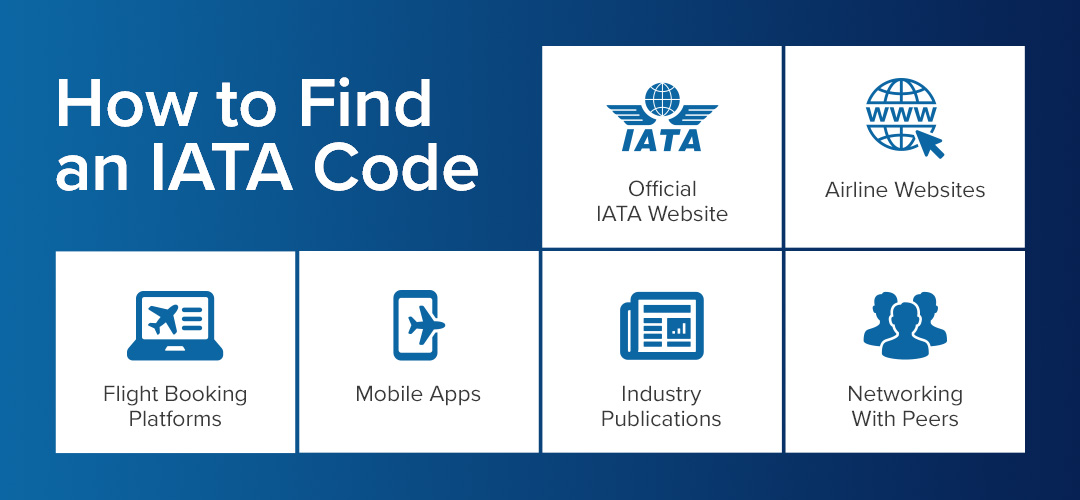
1. Official IATA Website
The IATA’s official website includes a database of IATA codes for your shipments. Use the search function to find a specific airport or airline code. The resource is updated regularly, providing you with the most recent information.
2. Airline Websites
Most commercial airlines include their IATA codes on their websites. This can be especially useful when you’re dealing with a specific carrier and need to use the correct code for bookings and logistics. Additionally, some airlines even offer context on their routes and services — EMO Trans has strong relationships with many of these airlines, making sure you have the correct codes and information for your bookings.
3. Flight Booking Platforms
Many flight booking websites and travel agencies have built-in tools that display IATA codes when searching for flights. This is a great feature when you need to reference a code in the planning stages, providing quick comparisons between different carriers and routes.
4. Mobile Apps
Many mobile applications cater to travel and logistics professionals. These apps often include features for IATA code lookup, so you can access codes on the go. This is especially convenient when you need to reference a code while traveling or managing shipments remotely.
5. Industry Publications
Many logistics and aviation industry publications provide lists of IATA codes in their resources. These resources can be especially convenient when you frequently deal with air freight — you can subscribe to receive the latest industry trends and changes in codes, ensuring you’re always informed.
6. Networking With Peers
Connecting with other logistics professionals can also be a valuable way to stay updated on IATA codes. You can share insights within the industry that help streamline your processes. Industry forums or conferences are examples of opportunities where you can learn from others and gain best practices.
Different Airline IATA Codes
Over 5,000 airlines operate worldwide, each with a unique IATA code. Familiarizing yourself with these codes will help you with routing, documentation and other essential logistics tasks. These are some of the different airline IATA codes you may come across:
Air France IATA Code
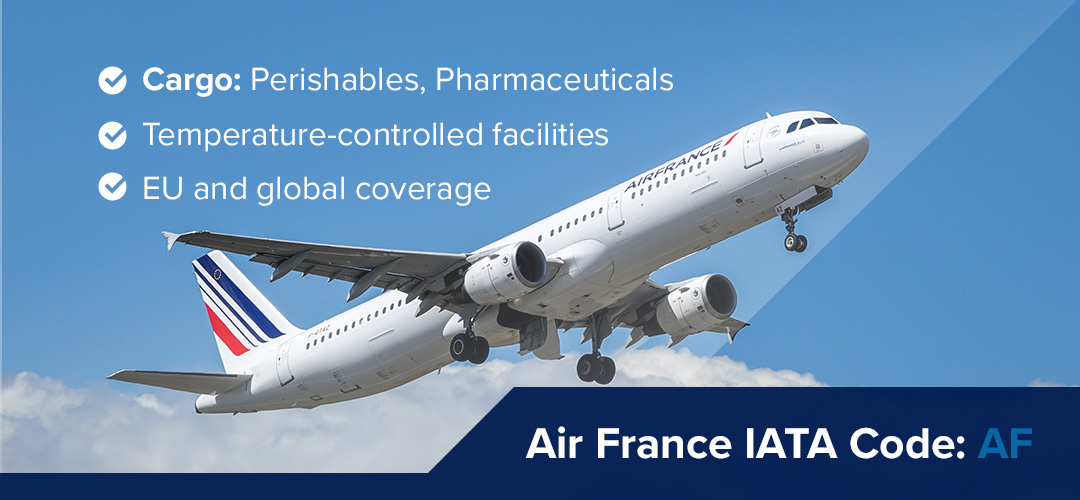
Air France operates under the IATA code “AF.” As one of the leading airlines in Europe, it offers an extensive cargo network connecting various international destinations. Air France Cargo also provides specialized services for perishables and pharmaceuticals, making it an important airline for any logistics professional dealing with sensitive shipments.
The airline’s cargo facilities also have temperature-controlled environments, protecting food products, medical supplies and other essential goods. Additionally, Air France’s strategic partnerships with other carriers mean it can provide seamless logistics solutions across Europe and beyond.
Alaska Airlines IATA Code
Alaska Airlines, identified by the IATA code “AS,” focuses primarily on the U.S. West Coast and Alaska, connecting air freight in remote areas. Alaska Airlines has a dedicated cargo division specializing in transporting perishable goods, making it essential for logistics professionals in this region.
The airline is especially important when shipping seafood, a major industry in Alaska. Understanding its capabilities can help you ensure timely deliveries of fresh products, which can be challenging when shipping goods to and from isolated areas. Additionally, Alaska Airlines’ partnerships with other carriers expand its reach, further benefiting logistics operations.
American Airlines IATA Code
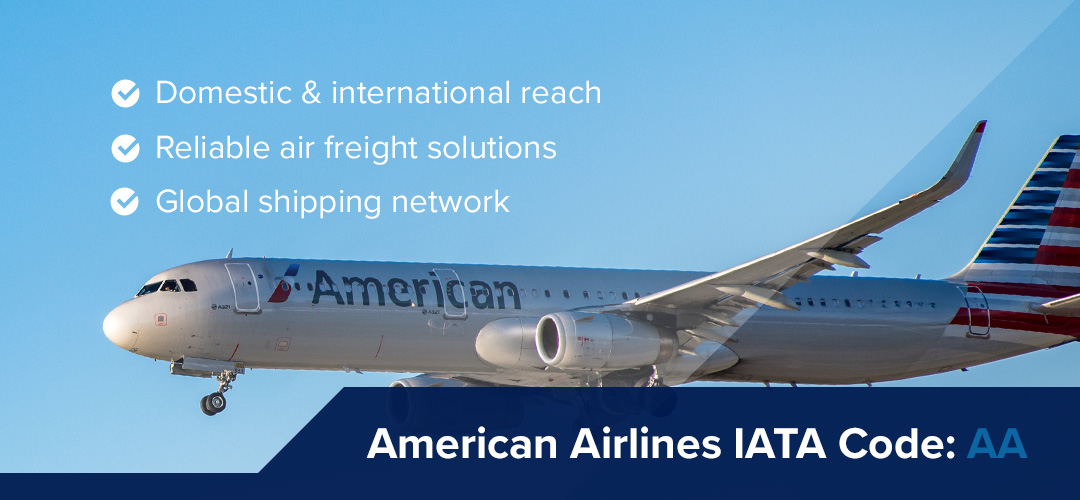
American Airlines operates under the IATA code “AA.” This code is widely recognized in the industry and used in everything from ticketing and flight schedules to cargo operations. Memorizing it will help you complete your documentation and prepare shipments when dealing with air freight involving this prominent airline. Its extensive network — both domestic and international — allows the quick transit of goods across all types of markets, making it a preferred choice for logistics experts.
All Nippon Airways IATA Code
All Nippon Airways Cargo, represented by the IATA code “NH,” focuses mostly on freight transport. The airline is known for its reliability and efficiency, especially when handling shipments that call for temperature control and careful handling. You’ll need to understand this code when working with Japanese exports and imports. ANA Cargo offers specialized services and can tailor them to specific industries like electronics or pharmaceuticals. That way, you know you can make timely deliveries while ensuring product integrity.
Avianca IATA Code
Avianca is Colombia’s national airline, operating under the IATA code “AV.” If you frequently manage shipments to South America, you may often refer to this code. The airline provides numerous cargo services and supports trade between Colombia and international markets like North America and Europe. Its cargo division can handle various types of freight, from textiles to perishables.
British Airways IATA Code
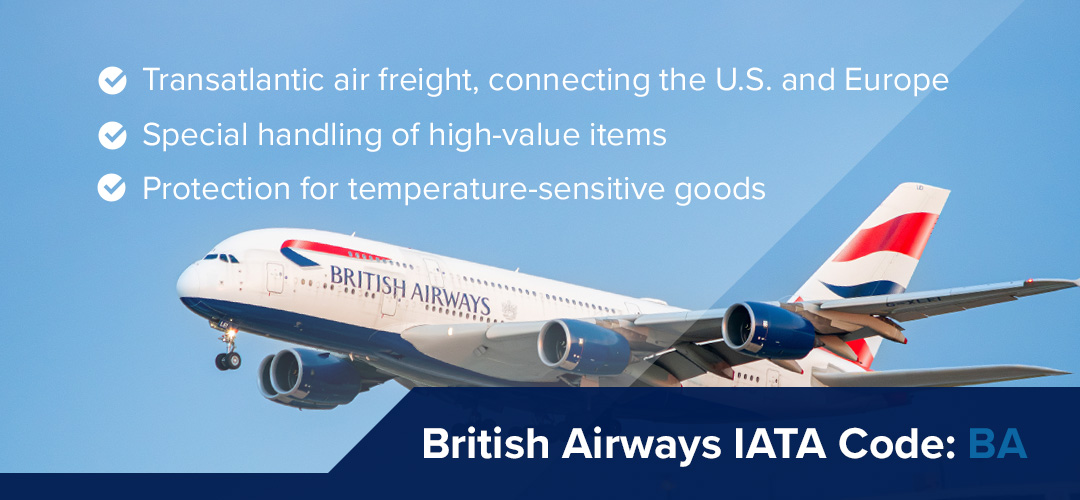
British Airways operates under the IATA code “BA.” It plays a vital role in transatlantic air freight, connecting the U.S. and Europe. Familiarizing yourself with BA’s operations will help you manage many shipments across the Atlantic. Its cargo offers services like special handling of high-value items and protection for temperature-sensitive goods.
Cathay Pacific IATA Code
Cathay Pacific is based in Hong Kong and operates under the IATA code “CX.” This airline is significant in the Asia-Pacific region, making it important to know the code if you work in or with partners in Asia. Cathay Pacific Cargo specializes in high-value and time-sensitive goods, with cargo facilities that use state-of-the-art technology for efficient shipments.
Delta Air Lines IATA Code
As one of the leading U.S. carriers, Delta operates under the IATA code “DL.” The airline offers extensive domestic and international routes, making it important in air freight logistics. Delta Cargo provides specialized services for the automotive, health care and retail industries, with a focus on customer service and reliability. Knowing the DL code is important when coordinating shipments across Delta’s vast network.
Emirates IATA Code
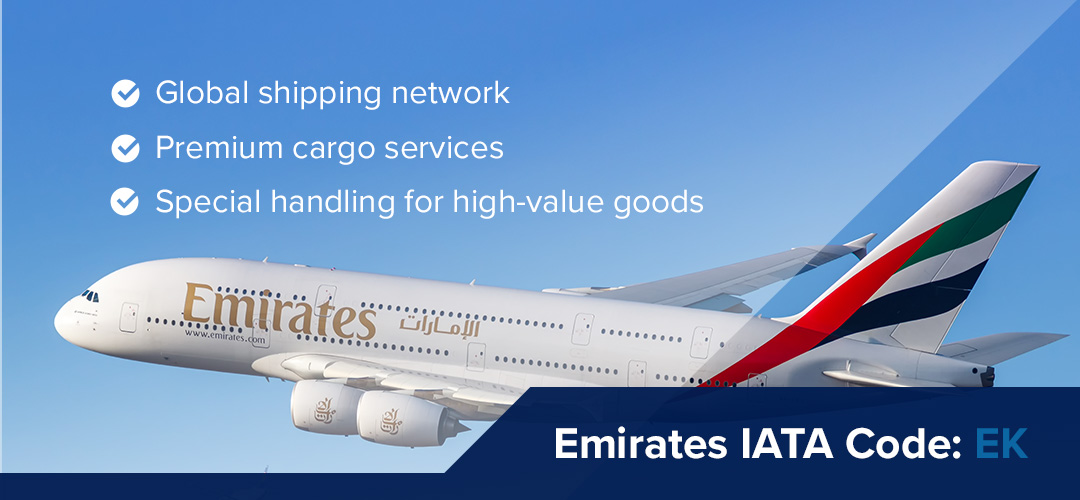
Emirates, a prominent airline based in Dubai, uses the IATA code “EK.” The airline is known for its vast international network, making it an essential part of global logistics. Understanding this code will help you manage shipments through the Middle East. Its modern fleet and state-of-the-art cargo facilities make it essential in international supply chains.
Jet Airways IATA Code
Jet Airways, operating with the IATA code “9W,” is a well-known carrier in India. The airline remains crucial in connecting air freight services within India and internationally — especially for time-sensitive shipments.
JetBlue IATA Code
JetBlue Airways is identified by the IATA code “B6.” This airline has grown significantly in the air freight sector, so it’s important to know its operational codes for fast, accurate shipping. JetBlue’s focus on the U.S. market, particularly in the Northeast and Florida, makes it an important carrier for domestic logistics.
KLM Royal Dutch Airlines IATA Code
KLM, operating under the IATA code “KL,” is the flag carrier of the Netherlands. It’s known for its extensive international network and offers services like express freight and specialized handling for high-value items. Familiarize yourself with KLM when managing shipments to and from Europe. The airline is known for its efficiency in handling diverse cargo types, making it an important partner for logistics professionals involved in transcontinental trade.
Lufthansa IATA Code
Lufthansa, Germany’s flagship carrier, is designated with the IATA code “LH.” As a major airline in Europe, it plays an important role in international air freight. Lufthansa Cargo offers a range of logistics services, including specialized handling for pharmaceuticals and perishables. Understanding the LH code will help coordinate shipments to and from Germany and across Europe, as the airline connects key markets globally.
PopulAir IATA Code
Designated by its “HP” IATA code, PopulAir is a Sweden-based passenger and cargo airline. Its main hub is Stockholm Arlanda Airport, and the airline was known as Amapola Flyg from 2004 to 2023. This airline operates across Sweden, so understanding this IATA code is essential if you work in this Scandinavian country.
Qantas Airline IATA Code
Australia’s largest airline, Qantas, uses the IATA code “QF.” The airline is critical in shipping cargo to and from the Asia-Pacific region. Their cargo services include temperature-sensitive solutions for pharmaceuticals and perishables. Qantas Freight also offers tailored solutions for certain industries, making sure each shipment is handled with care and delivered promptly. You’ll want to understand the QF code if you manage air freight in and out of Australia.
Qatar Airways IATA Code
Qatar Airways is identified by the IATA code “QR.” Based in Doha, this airline has rapidly expanded its global reach, making it a significant player in international logistics. Qatar Airways Cargo offers specialized services, including the transport of sensitive and high-value goods. The airline’s modern fleet and extensive network ensure timely deliveries across continents.
Singapore Airlines IATA Code
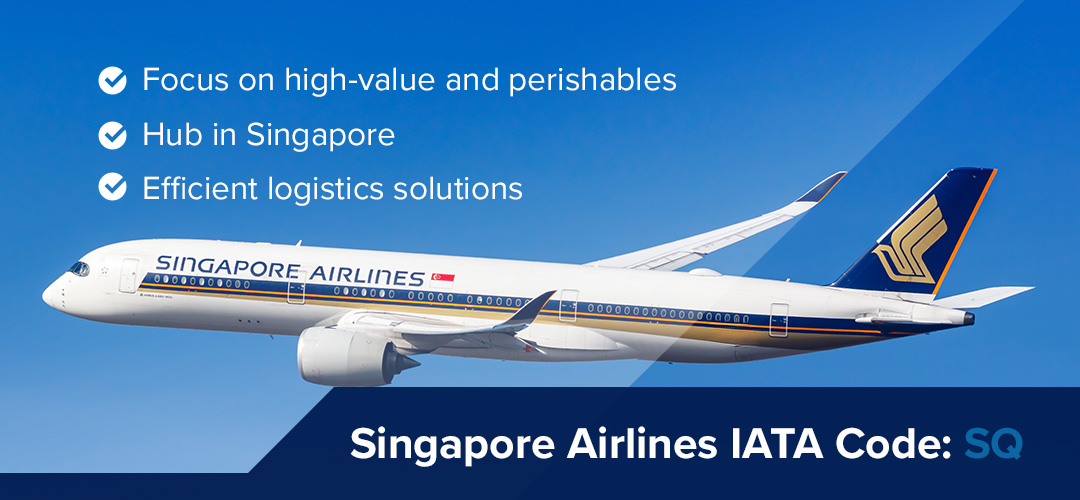
Recognized for its exceptional service, Singapore Airlines uses the IATA code “SQ.” It operates a robust cargo division that offers connections to major global markets through its hub in Singapore. Singapore Airlines Cargo is known for its reliability and efficiency, particularly in handling high-value and perishable shipments.
Southwest Airlines IATA Code
Southwest Airlines, recognized by the IATA code “WN,” is a major low-cost carrier in the U.S. It serves numerous domestic routes. While Southwest primarily focuses on passenger service, its cargo division offers logistics solutions that can benefit businesses needing to ship goods across the U.S. Understanding the WN code can help you optimize your shipping routes and manage costs more effectively.
Swiss Air Lines IATA Code
Swiss International Air Lines operates under the Swiss IATA code “LX.” It’s an especially important airline for air freight logistics in Europe, particularly for shipments to and from Switzerland. LX offers a range of cargo services, including express delivery and specialized handling of valuable goods.
Turkish Airlines IATA Code
Turkish Airlines uses the IATA code “TK.” As Turkey’s national flag carrier, it operates a vast network connecting Europe, Asia and beyond. Turkish Cargo is recognized for its effective logistics solutions, including a dedicated freighter fleet to move goods between continents. TK is an IATA code you’ll need to reference if you manage shipments through Turkey’s major hubs.
United Airlines IATA Code
United Airlines uses the IATA code “UA.” As one of the largest airlines in the U.S., it plays a significant role in air freight logistics, especially for shipments that require transcontinental travel. United Cargo offers specialized handling, temperature control for sensitive shipments and a variety of other critical services.
Different Airport IATA Codes
This IATA airport codes list offers an overview of IATA codes used worldwide. As a logistics professional, knowing these codes can help you quickly identify airports, assess their capabilities and navigate international shipping with ease. Being able to reference the codes can also improve communication and operational efficiency — two crucial components for successful air freight logistics operations.
Ministro Pistarini International Airport
Buenos Aires’ primary airport, Ministro Pistarini International Airport, is recognized as “EZE.” This Argentina IATA code is important to know if you frequently handle air freight to and from South America. As a major gateway for international cargo, EZE connects Argentina with markets in North America, Europe and Asia.
Lynden Pindling International Airport
The main Bahamas IATA code is for Lynden Pindling International Airport — “NAS.” It’s a major gateway for goods entering the country and has extensive connections to the U.S. and other Caribbean islands. It allows for the shipment of perishable goods, consumer products and construction materials.
Ngurah Rai International Airport
Ngurah Rai International Airport in Bali is recognized by the IATA code “DPS.” This airport is significant for tourism and logistics professionals handling shipments to the popular destination. While it’s a gateway for travelers, it also allows logistics professionals to manage shipments of goods like handcrafts, textiles and agricultural products from Indonesia. Understanding the IATA code for Bali will help you with your inbound and outbound shipments, especially during peak tourist seasons.
Berlin Brandenburg Airport
Berlin has two major airports, with Berlin Brandenburg Airport designated by the IATA code “BER.” This is a key airport if you need to manage shipments to Germany’s capital. This Berlin IATA code highlights a significant hub for both passenger and cargo flights, with extensive connections to other European cities and international destinations. This hub’s operational capabilities include handling time-sensitive shipments and a robust setup for cargo processing.
Copenhagen Airport
“CPH” is the main Denmark IATA code, signifying Copenhagen Airport. This airport is a massive hub for air travel in Scandinavia, connecting a large network of global destinations in Europe. The airport also has advanced facilities to handle cargo like perishables and pharmaceuticals.
Dubai International Airport
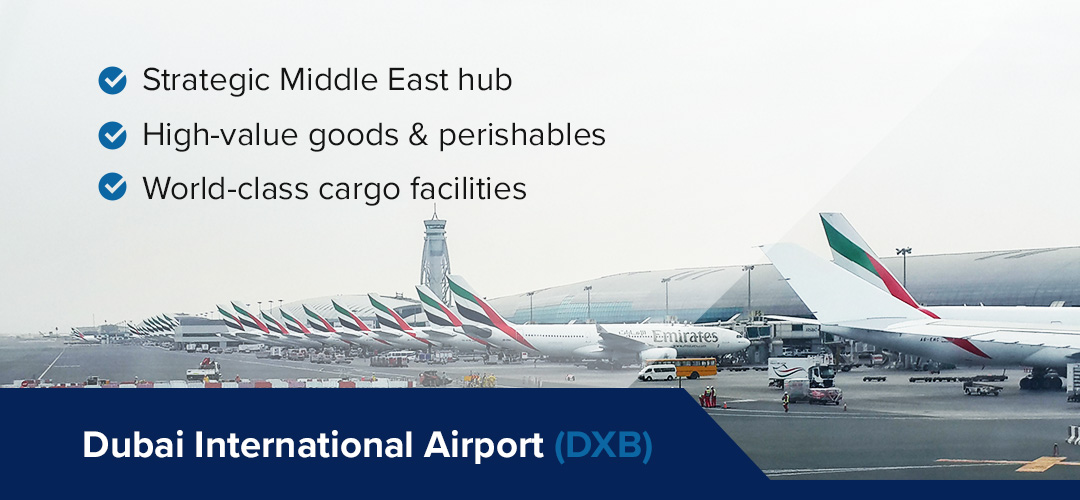
Dubai International Airport, a major global hub, is designated with the Dubai airport IATA code “DXB.” This airport helps manage shipments to and from the Middle East. It serves as a key transit point for goods traveling between Asia, Europe and Africa, with a robust cargo infrastructure that can handle a wide range of products, including high-value goods and perishables.
London Gatwick Airport
“LGW,” the Gatwick IATA code, refers to one of London’s largest airports. It’s a prominent hub for international air traffic, connecting many destinations across Europe, Asia and North America. The airport can handle diverse shipments, including e-commerce packages, automotive parts and perishables.
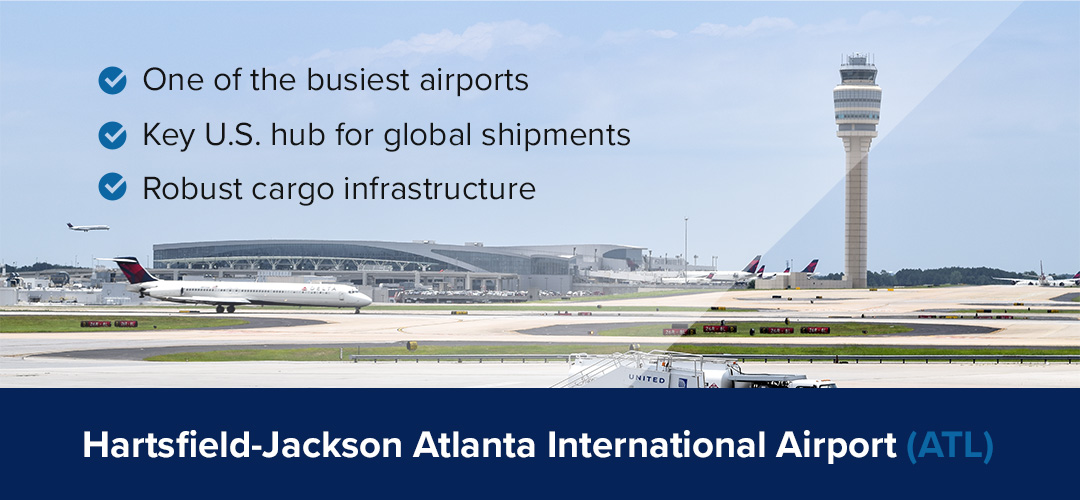
Hartsfield-Jackson Atlanta International Airport
Hartsfield-Jackson Atlanta International Airport is designated with the Atlanta, Georgia IATA code “ATL.” It’s one of the busiest airports in the world, serving as a hub for both domestic and international shipments, with numerous cargo services available. The airport’s strategic location in the southeastern U.S. connects many regions, leading to faster transits.
Daniel K. Inouye International Airport
Daniel K. Inouye International Airport in Honolulu, which uses the Hawaii IATA code “HNL,” handles air freight to and from the Pacific region. HNL connects shipments traveling between the U.S. mainland, Asia and islands in Hawaii. The airport’s cargo facilities support the transport of perishables, consumer goods and other products critical to the local economy.
Heathrow Airport
The IATA code for Heathrow is “LHR.” A major international gateway in London, this airport connects numerous airlines and is critical if you’re coordinating shipments to and from Europe.
Helsinki-Vantaa Airport
Helsinki-Vantaa Airport in Finland is recognized by the IATA code “HEL.” The airport is essential in Northern European air freight, with extensive connections to Asia and North America. Its cargo facilities offer specialized services for both high-value and temperature-sensitive goods.
George Bush Intercontinental Airport
George Bush Intercontinental Airport in Houston, Texas, is assigned the IATA code “IAH.” This airport is vital for air freight logistics in Texas and is one of the busiest in the U.S. IAH connects flights to Latin America, Europe and Asia, helping with international trade. The airport’s cargo facilities can handle shipments like oil and gas products, electronics, and perishables.
Keflavik International Airport
The Iceland IATA code “KEF” recognizes Keflavik International Airport. This airport is a connection point for transatlantic air freight, efficiently routing shipments between North America and Europe. Its cargo facilities handle various goods, from seafood to pharmaceuticals and electronics.
Chhatrapati Shivaji Maharaj International Airport
“BOM,” the Mumbai airport IATA code, signifies Chhatrapati Shivaji Maharaj International Airport. One of India’s busiest airports, BOM is a major gateway for goods entering and leaving India, supporting trade with Asia, Europe and North America. The airport’s cargo terminal handles products like textiles, electronics and perishables. It also offers temperature-controlled storage solutions.
Munich International Airport
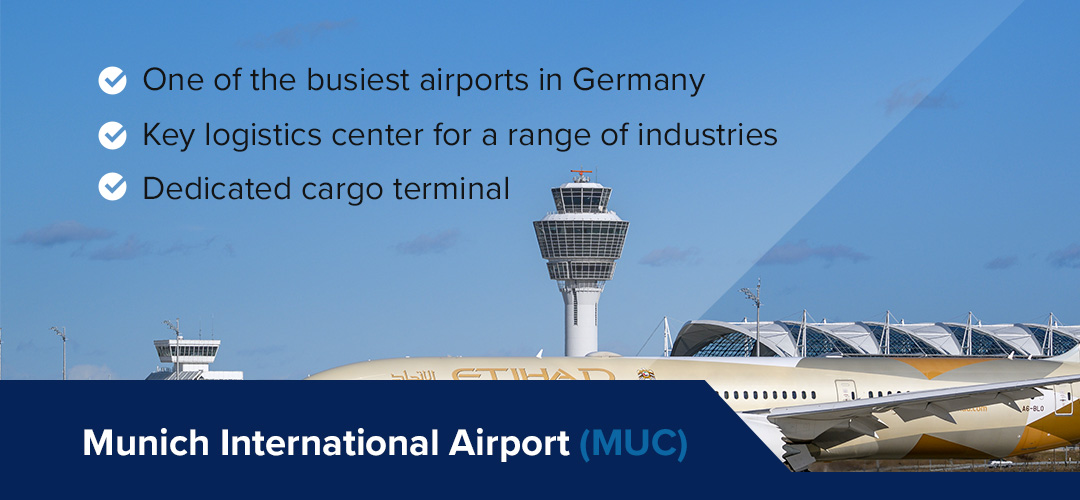
This airport is a major European hub and uses the Munich IATA code “MUC.” As one of the busiest airports in Germany, you’ll likely need to reference this code when coordinating air freight within Europe. It’s a key logistics center for a range of industries, from automotive and machinery to technology. MUC also has a dedicated cargo terminal for express freight and handling oversized cargo.
Newark Liberty International Airport
The Newark Liberty International Airport IATA code is “EWR.” It’s essential for international air freight — particularly shipments to and from the northeastern U.S. EWR is a major hub for connecting flights to Europe, Asia and South America. Its cargo facilities offer a range of services, including express freight and specialized handling for high-value shipments.
Northeast Philadelphia Airport
The Northeast Philadelphia Airport IATA code is “PNE.” While smaller, it’s important to regional air traffic, making its code relevant for local logistics. PNE offers general aviation services and limited commercial flights, providing a convenient option for businesses and individuals in the Philadelphia area.
John Glenn Columbus International Airport
John Glenn Columbus International Airport has the IATA code “CMH.” It connects both domestic and international destinations while offering services kuje freight forwarding and logistics support. Knowing this Ohio IATA code is essential when managing shipments in and out of the Midwest.
Orlando International Airport
Orlando International Airport, designated as “MCO,” is an important airport for shipments to Florida and the southeastern U.S. This Orlando IATA code points to one of the busiest airports in the country, serving as a gateway for both passenger and cargo flights. The airport’s cargo facilities handle consumer goods, electronics and perishables.
Keflavik International Airport
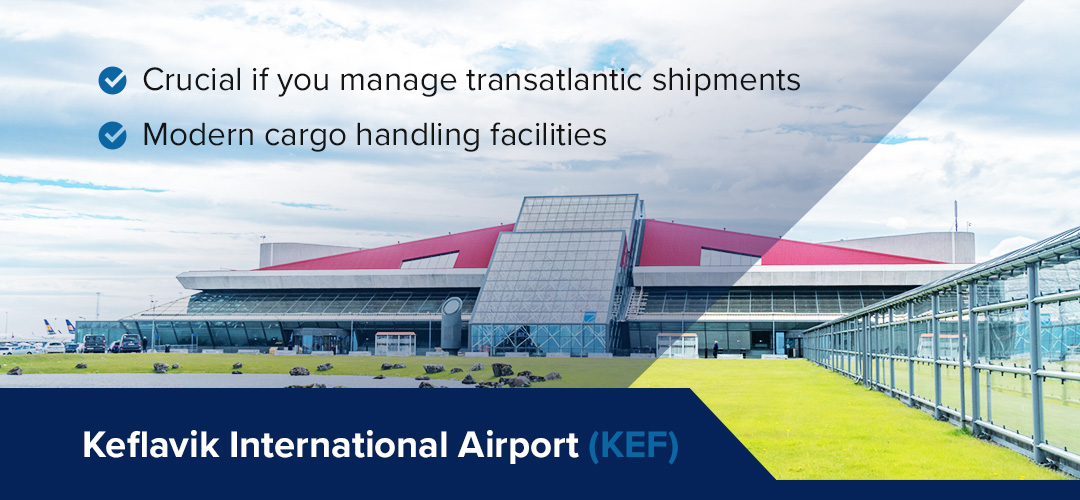
Located in the capital of Iceland, Keflavik International Airport uses the Reykjavik IATA code “KEF.” It’s in a central point, connecting air traffic between North America and Europe — crucial if you manage transatlantic shipments. Its strategic location also promotes shorter cargo transit times. With its modern cargo handling facilities, KEF deals with both imports and exports, especially goods like seafood and pharmaceuticals.
Leonardo da Vinci International Airport
Leonardo da Vinci International Airport is recognized by the Rome IATA airport code “FCO.” This airport is a major gateway for international cargo, connecting Italy with global markets. The airport’s cargo facilities can handle a range of goods, including fashion items, automotive parts and food products.
Singapore Changi Airport
Singapore Changi Airport, a major international hub, is assigned the Singapore IATA code “SIN.” This airport is consistently ranked among the world’s best airports and is important for shipments to and from Asia-Pacific regions. Its advanced cargo facilities cater to industries ranging from electronics and pharmaceuticals to perishables. Its strategic location makes it perfect for handling goods traveling between Asia and the rest of the world.
Hewanorra International Airport
“UVF” is the main St. Lucia IATA code, designating Hewanorra International Airport. This airport is important for coordinating shipments to the Caribbean. Its cargo facilities support the transport of agricultural goods, tourism-related items and general cargo.
Zurich Airport
Zurich Airport, which has the Switzerland IATA code “ZRH,” is a major hub for connecting flights throughout Europe and beyond. It has extensive cargo facilities for high-value and time-sensitive shipments. The airport’s strategic location in Central Europe helps it support efficient trade across the continent.
Suvarnabhumi Airport
Suvarnabhumi Airport in Bangkok is identified by the IATA code “BKK.” This airport connects air freight within Southeast Asia and globally, both passenger and cargo flights. Knowing this Thailand IATA code will assist you in conducting trade throughout the region, with state-of-the-art cargo handling facilities managing shipments like textiles, electronics and food products.
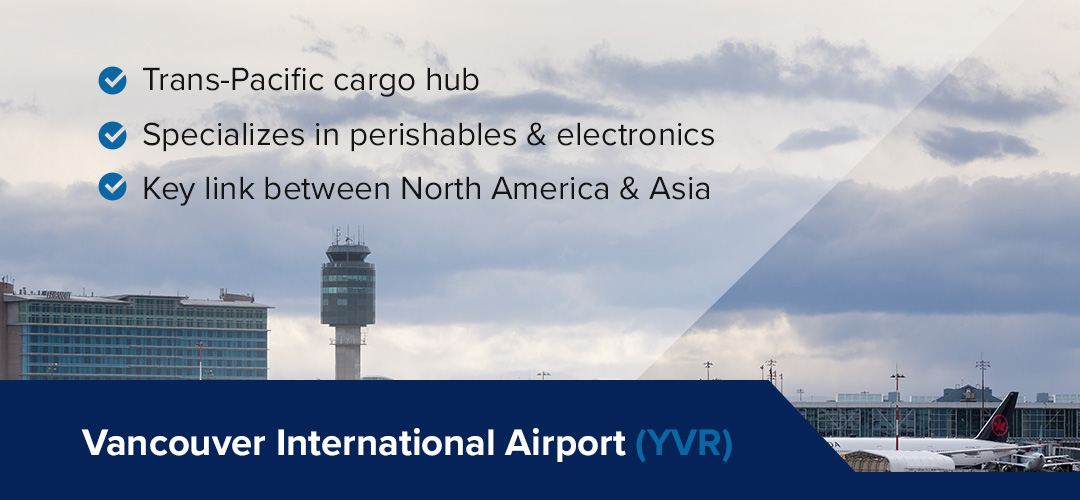
Vancouver International Airport
Vancouver International Airport, assigned the IATA code “YVR,” is important for air freight to and from Canada. YVR serves as a major gateway for goods entering and leaving North America, with cargo facilities handling products like perishables, electronics, natural resources and more. The airport’s strategic position on the Pacific Rim makes it critical in trans-Pacific trade — understanding the IATA code for Vancouver is essential if you do business in this region.
Streamline Your Air Freight and Partner With EMO Trans
When planning air freight routes, IATA codes will help you direct shipments to the right terminals and make completing paperwork much easier. Knowing these codes can also help you comply with international regulations, provide timely shipments and streamline your processes, helping you identify locations across carriers and systems. Use our IATA code list as a reference and partner with EMO Trans for advanced global logistics solutions. With exceptional customer service, a customized customer portal and tailored quotes, we can help you meet your unique logistics needs.
Whether you’re transporting delicate items, require specialized handling for parts and accessories or need comprehensive project logistics, our team is equipped to deliver excellence. Stay ahead of the game with our state-of-the-art customer portal, which offers detailed shipment analytics for precision and peace of mind. We understand the intricacies of air freight logistics and are dedicated to simplifying the process for you, offering a seamless, stress-free experience.
Ready to experience a higher level of service? Partner with EMO Trans, and let us tailor a logistics strategy that perfectly fits your unique requirements. Request a quote today and discover how we make logistics easier, one shipment at a time.

